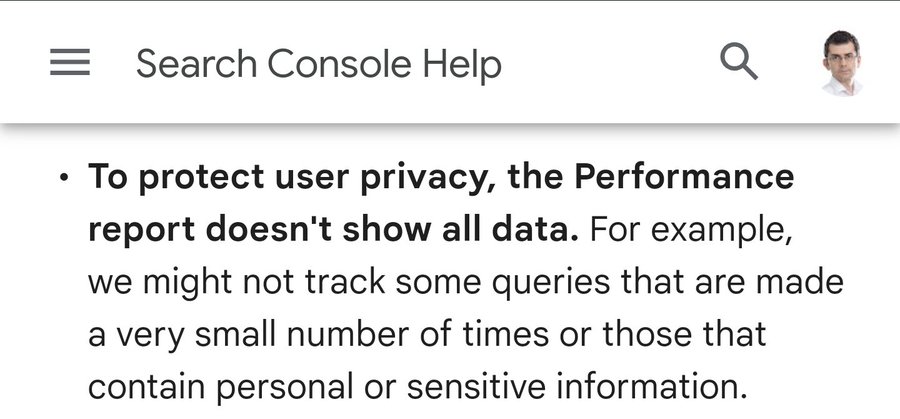Unfortunately, the primary data source we’re provided from Google about our search performance on their site is inaccurate, incomplete, and obscured. I tweeted out a simple request for a quote for another story I was working on about how to leverage GSC data and its potential inaccuracy. I was blown away by the variety of ways my fellow experts discovered the unreliability of the data provided.
I’ve ironically updated this article to include my OWN stats for this very post, where it got 148 clicks in GSC, but only got detail for 5 of those clicks over the last 3 months of data collection. That is just THREE PERCENT of the clicks reported, and ONE query is defined as receiving those clicks!
Google Business Profile Clicks Not Included
It looks like a huge amount of traffic from the Google Business Profile from mobile is completely missing in Search Console, and some data from desktop. I believe one possible reason for this is that when you click on a listing in the 3-pack on mobile, you get a URL string that says Google/localservices/profile whereas on a computer you get Google/search.
Joy Hawkins

I worked with a compression glove ecommerce site, helping people with arthritis, and they had 201 clicks at the top of the chart. However, it only gave detail for 96 total clicks. That’s nearly 50%. A literal 50/50!
Google Search Console Data is Limited in the UI, AND “Sampled”

If you thought that Google had decided to share “the whole picture” with you, when it comes to GSC data, you’ve got two major problems to resolve. They withhold query data for “black box” reasons and also limit your access to the data through their UI interface.
Both the data in the report interface and the data exported are aggregated and filtered in different ways. Below are the two main limitations to the data: privacy filtering and daily data row limit.
Google Search Central Blog
- There is no row for anonymized queries in the report table or API (added here for illustration purposes), so if you sum up clicks for all the rows, you’ll not find the same number of clicks as the chart totals. For example in this case you’d see 450 when you sum up the rows, but you’d see 550 in the chart totals.
- The anonymized queries are omitted whenever a filter is applied, so there will be a discrepancy if you compare the sum of clicks in the chart totals to the sum of clicks containing
some_stringand not containingsome_string. In this case, if you use filters to include only queries that contain the word “fiction”, you’ll see 175 clicks, and if you exclude queries that contain the word “fiction”, you’ll see 275 clicks, summing up to 450 clicks, while in the chart total you’ll see 550 clicks.- Due to limitations related to serving latency, storage, processing resources, and others, Search Console has a limit on the amount of data that can be displayed or exported. The maximum you can export through the Search Console user interface is 1,000 rows of data.
Even If You Use The API – It’s Not The Whole Picture
Understanding the Limitations of Google Search Console Data Accuracy
- Data Sampling: Google Search Console may sample your data in order to speed up data processing. This implies that Google will only utilize a subset of your website data to represent the complete dataset, which may result in erroneous statistics if the sample size is insufficient.
- Click Data: The click data provided by Google Search Console is based on the number of clicks registered by Google when people click on your website in the search results. Nevertheless, not all clicks are logged, which might lead to data disparities. Google, for example, may not register clicks on highlighted snippets or photos, resulting in reduced click counts in the report.
- Reporting Delays: Because Google Search Console data is not real-time, it may not be up to current at the time of analysis. Google may require some time to process the data and update the reports, resulting in reporting delays.
- Data Aggregation: Google Search Console aggregates data at many levels, including website, page, and query. This implies that certain data may be mixed or clubbed together, resulting in data errors. Data from several pages of your website, for example, may be aggregated into a single report, making it impossible to assess the performance of particular pages.
Solutions to Address Inaccurate Data in Google Search Console
- Utilize other analytics tools: Website owners may use other analytics tools like Google Analytics or third-party tools like SEMrush or Ahrefs to cross-check the data in Google Search Console. Website owners can compare data and find differences by utilizing several tools. Tools like SEOGets can also help you with some of the data hassle associated with Google Search Console.
- Examine tracking code implementation: If the data in Google Search Console is incorrect, it might be due to tracking code implementation difficulties. Website owners should check their tracking code to ensure that it is correctly installed and set.
- While Google Search Console gives statistics on impressions and clicks, it does not provide information on search engine rankings. Website owners should check changes in search engine rankings over time using tools like Google Search or third-party solutions.
- Consider user behavior: Google Search Console gives statistics on clicks and impressions, but not on user behavior on the site. Other metrics, including bounce rate, time on site, and conversion rate, should be considered by website owners to gain a more full view of their site’s success.
- Watch for patterns over time: Webmasters should keep an eye out for trends over time rather than just concentrating on Google Search Console’s exact figures. Website owners may see trends and decide how best to optimize their site by tracking changes in traffic, click-through rate, and other data over time.
Why Context Matters When Analyzing Data in Google Search Console
When analyzing data in Google Search Console, it’s important to consider the context in which the data is being collected. This means taking into account factors like seasonal fluctuations, website updates, algorithm updates, and industry trends. For example, a website may experience a dip in traffic during a slow season for their industry, or a change in search engine rankings due to an algorithm update. By considering these factors, website owners can get a more complete picture of their site’s performance and make informed decisions about optimizing their site.
Contextualizing the data in Google Search Console can help website owners identify patterns and make data-driven decisions. By understanding the factors that may impact their site’s performance, website owners can make adjustments to their strategy and measure the impact of those changes. Ultimately, this can help website owners improve their search engine rankings, drive more traffic to their sites, and achieve their business goals.
